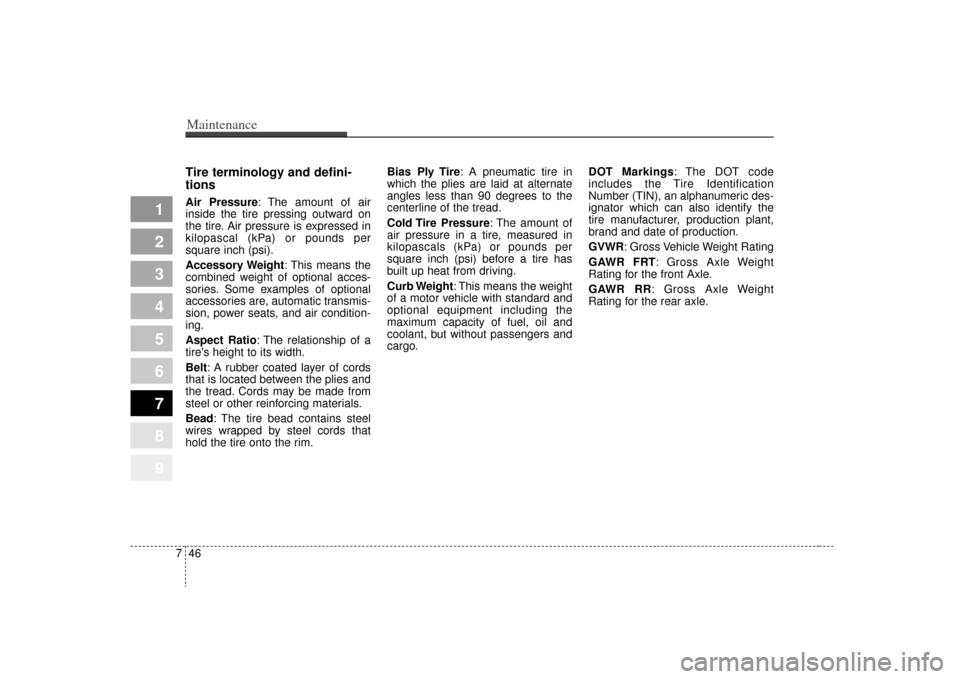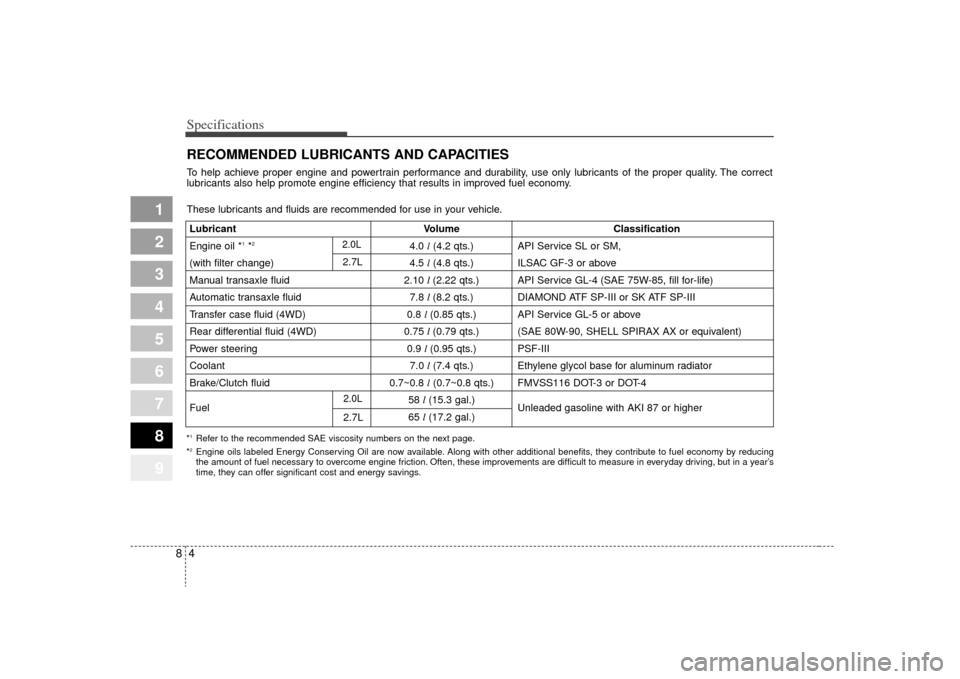Page 313 of 371
Maintenance47
1
2
3
4
5
6
7
8
9
MAINTENANCE SCHEDULE
MAINTENANCEINTERVALS
MAINTENANCE
ITEM
Engine control system
Kilometers or time in months, whichever comes first
× 1,000 km 8 16 24 32 40 48 56 64 72 80 88 96 104 112 120 128
# Months 4 8 12 16 20 24 28 32 36 40 44 48 52 56 60 64
Engine oil & engine oil filter (1) R R R R R R RRRRRRR RRR
Drive belts (tension) I I I I
Cooling system hoses & connections I I I I I
Engine coolant (1) I I I I I R IIIIIRI III
Fuel filter RR
Fuel tank cap, lines, EVAP canister and hoses
II
Fuel tank air filter (if equipped) I R I R I
Air cleaner element (2) I I I I I R IIIIIRI III
Ignition wires I I
Spark plugs 2.0L (Platinum)
R
2.7L (lridium)
PCV valve (if equipped) I I I I
Idle speed I I I I I
Valve clearance 2.0L I
Engine timing belt RReplace every 160,000 km
Page 318 of 371

79
Maintenance
Timing belt (if equipped)Inspect all parts related to the timing
belt for damage and deformation.
Replace any damaged parts immedi-
ately.Vapor hose and fuel filler capThe vapor hose and fuel filler cap
should be inspected at those inter-
vals specified in the maintenance
schedule. Make sure that a new
vapor hose or fuel filler cap is cor-
rectly replaced.
Vacuum crankcase ventilation
hoses Inspect the surface of hoses for evi-
dence of heat and/or mechanical
damage. Hard and brittle rubber,
cracking, tears, cuts, abrasions, and
excessive swelling indicate deterio-
ration. Particular attention should be
paid to examine those hose surfaces
nearest to high heat sources, such
as the exhaust manifold.
Inspect the hose routing to assure
that the hoses do not come in con-
tact with any heat source, sharp
edges or moving component which
might cause heat damage or
mechanical wear. Inspect all hose
connections, such as clamps and
couplings, to make sure they are
secure, and that no leaks are pre-
sent. Hoses should be replaced
immediately if there is any evidence
of deterioration or damage.
Air cleaner filterA Genuine KIA air cleaner filter is
recommended when the filter is
replaced.Spark plugsMake sure to install new spark plugs
of the correct heat range.Valve clearanceInspect excessive valve noise and/or
engine vibration and adjust if neces-
sary. An authorized KIA dealer
should perform the operation.
1
2
3
4
5
6
7
8
9
Page 355 of 371

Maintenance46
7
1
2
3
4
5
6
7
8
9
Tire terminology and defini-
tionsAir Pressure: The amount of air
inside the tire pressing outward on
the tire. Air pressure is expressed in
kilopascal (kPa) or pounds per
square inch (psi).
Accessory Weight : This means the
combined weight of optional acces-
sories. Some examples of optional
accessories are, automatic transmis-
sion, power seats, and air condition-
ing.
Aspect Ratio : The relationship of a
tire's height to its width.
Belt: A rubber coated layer of cords
that is located between the plies and
the tread. Cords may be made from
steel or other reinforcing materials.
Bead: The tire bead contains steel
wires wrapped by steel cords that
hold the tire onto the rim. Bias Ply Tire
: A pneumatic tire in
which the plies are laid at alternate
angles less than 90 degrees to the
centerline of the tread.
Cold Tire Pressure: The amount of
air pressure in a tire, measured in
kilopascals (kPa) or pounds per
square inch (psi) before a tire has
built up heat from driving.
Curb Weight: This means the weight
of a motor vehicle with standard and
optional equipment including the
maximum capacity of fuel, oil and
coolant, but without passengers and
cargo. DOT Markings: The DOT code
includes the Tire Identification
Number (TIN), an alphanumeric des-
ignator which can also identify the
tire manufacturer, production plant,
brand and date of production.
GVWR: Gross Vehicle Weight Rating
GAWR FRT: Gross Axle Weight
Rating for the front Axle.
GAWR RR: Gross Axle Weight
Rating for the rear axle.
Page 366 of 371

Specifications48
1
2
3
4
5
6
7
8
9
RECOMMENDED LUBRICANTS AND CAPACITIES *1Refer to the recommended SAE viscosity numbers on the next page.
*2Engine oils labeled Energy Conserving Oil are now available. Along with other additional benefits, they contribute to fuel econo my by reducing
the amount of fuel necessary to overcome engine friction. Often, these improvements are difficult to measure in everyday driving, but in a year’s
time, they can offer significant cost and energy savings.Lubricant Volume Classification
Engine oil *
1*2
4.0 l(4.2 qts.) API Service SL or SM,
(with filter change) 4.5 l(4.8 qts.) ILSAC GF-3 or above
Manual transaxle fluid 2.10 l (2.22 qts.) API Service GL-4 (SAE 75W-85, fill for-life)
Automatic transaxle fluid 7.8 l (8.2 qts.) DIAMOND ATF SP-III or SK ATF SP-III
Transfer case fluid (4WD) 0.8 l (0.85 qts.) API Service GL-5 or above
Rear differential fluid (4WD) 0.75 l (0.79 qts.) (SAE 80W-90, SHELL SPIRAX AX or equivalent)
Power steering 0.9 l (0.95 qts.) PSF-III
Coolant 7.0 l (7.4 qts.) Ethylene glycol base for aluminum radiator
Brake/Clutch fluid 0.7~0.8 l(0.7~0.8 qts.) FMVSS116 DOT-3 or DOT-4
Fuel 58
l (15.3 gal.)
Unleaded gasoline with AKI 87 or higher
65 l (17.2 gal.)
2.0L2.7L2.0L2.7L
To help achieve proper engine and powertrain performance and durability, use only lubricants of the proper quality. The correct
lubricants also help promote engine efficiency that results in improved fuel economy.
These lubricants and fluids are recommended for use in your vehicle.